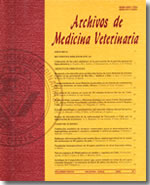Estimation of body weight by an indirect measurement method in developing replacement Holstein heifers raised on pasture
Main Article Content
Abstract
Scale is the most accurate means of measuring the actual body weight (BW) in developing heifers. However, when it is not available, indirect tools to estimate BW are needed. The objective of this study was to evaluate the distance between the left and right coxal tuberosity (DLRCT) as potential estimator of shrunk BW (SBW) of developing Holstein heifers as compared with the actual weight measured by an electronic scale. The study included pre-breeding Argentinean Holstein females from 3 to 21 months of age. A dataset comprising 496 observations was used to quantify the relationship between the DLRCT (cm) and the SBW (kg) by the least squared method. The power function Y = 0.131X2.0758, where X = DLRCT provided the best fit (P < 0.0001) for predicting SBW. A dataset comprising 194 observations was used to assess the strength of agreement of the power function. The Lin correlation coefficient value was 0.97 and the computed 95% CI was 0.965-0.979. The mean difference between observed and estimated SBW was -0.99 kg. There was no significant difference (t = -0.83; P = 0.41) in the mean SBW between observed and estimated data. As a predictor of SBW, particularly in heifers ≥ 5 months of age and ≤ 350 kg BW (i.e. ≤ 45 cm), the DLRCT demonstrated to be a useful alternative that can be easily applied during any practice usually performed on replacement heifers, without requiring a squeeze chute.

